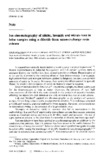Ion chromatography of nitrite, bromide and nitrate ions in brine samples using a chloride-form anion-exchange resin column
- Global styles
- MLA
- Vancouver
- Elsevier - Harvard
- APA
- Help
Share
抄録
In aquaculture research, maintenance of water culture quality is of great importance. Recent improvement in fishpond management and fish culture systems, such as intensive feeding and fertilization, have created complex problems. Deterrioration of weter quality is primarily the resulting effect of these improvements. Foe example, high-protein feeds and nitrogen fertilizers applied in fishponds produce considerable amount of nitrate in the water. Moreover, their synergistic effects cannot be ignored. Hence the routine determination of nitrite in fishpond water is required.
Since its introduction by Small et al., ion chromatography has been widely used for the determination of ions in water. However,the presence of very high concentrations of chloride is the main obstacles in the analysis of seawater samples, affecting the separation and detection not only of nitrite but also of other anions.
Itoh and Shinbori applied ion chromatography to the analysis of seawater using a 125-cm long column and a conductimetric detector. This technique provided by a simple and sensitive analysial method for brine samples. However, nitrite could not be determined owing to the presence of a large chloride peak.
Attempts to determine nitrite in seawater also led to innovations in the methodology. Lee and Field employeed a post-column cerium flourescence detection system to determine nitrite and nitrite in drinking water and seawater. The use of a pretreatment column in the silver form for removal of chloride has been reported.
Various detectors have been applied in ion chromatography in addition to the conductimetric detector. The UV detector has been shown to be luseful detector for several kinds of inorganic anions. Selected detection of specified inorganic ions can be achieved by tuning the wavelength of the UV detector in ion chromatography and also in ion-exclusion chromatography. The elemination of the chloride matrix interference in the sub-ppm determination of nitrite in seawater was achieved by a heart-cutting and recycling method using a dual detection system consisting of conductimetric and UV detectors. This method, however, requires valve switching during analysis and needs a long analysis time.
This paper describes a simple and rapid method of UV-absorbing anions, such as nitrite, nitrite and bromide, in brine samples using a chloride-form anion-exchange resin column combined with a UV detector.
Suggested Citation
Rokushika, S., Kihara, K., Subosa, P. F., & Leng, W.-X. (1990). Ion chromatography of nitrite, bromide and nitrate ions in brine samples using a chloride-form anion-exchange resin column. Journal of Chromatography A , 514(2), 355-361. https://doi.org/10.1016/S0021-9673(01)89410-3
Type
ArticleISSN
0021-9673Collections
- Journal Articles [1258]


